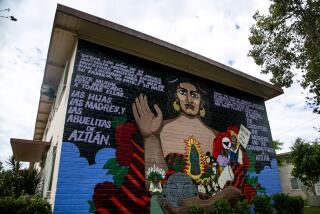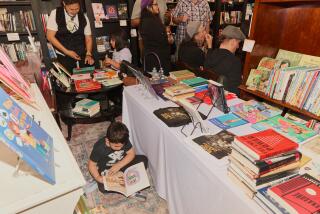Jazz Book Rescues Memories of Central Avenue Players
- Share via
It was a race against time and mortality to preserve the memories of jazz musicians who made Central Avenue in Los Angeles such a hot spot in the ‘30s and ‘40s. Sadly, those bandleaders, trumpeters and singers have been dying in alarming numbers in recent years.
But an effort to collect their oral histories, even with some gaps caused by death, has paid off with a new book published recently by the University of California Press. If a book signing party in Pasadena on Saturday was any measure, the sounds from long-shuttered nightclubs and concert halls of Central Avenue still reverberate through time.
Clora Bryant, one of the few successful female trumpeters of the era, recalled her first stroll along Central Avenue in 1945. “I get goose bumps thinking about it now,” she told a crowd of about 80 fans gathered Saturday. “I knew I was where I was supposed to be.”
Bryant was among seven veteran jazz musicians who collaborated as editors on “Central Avenue Sounds: Jazz in Los Angeles.” Co-editors Horace Tapscott and Gerald Wilson joined her for the brief panel discussion at Vroman’s Bookstore, along with other popular artists such as David Bryant, Gerald Wiggins and Coney Woodman, whose stories are also in the book.
For a bit Saturday, the talk was about recent quadruple bypass surgeries and strokes among their peers. After all, their ages average in the mid-70s.
Mainly the event--co-sponsored by the Los Angeles Jazz Society--celebrated how African Americans in the neighborhood around the Dunbar Hotel created music that had the world swinging despite racism of the time.
“L.A. truly contributed something of great cultural significance on this avenue,” said Steve Isoardi, who organized the book project and is also a co-editor. His other four partners were Buddy Collette, William Green, Jack Kelson and Marl Young.
Isoardi, a 48-year-old social studies and jazz history teacher who is white, might be seen as an odd man out among the otherwise black and elderly editorial board. But all involved said Isoardi was warmly welcomed as he, collaborating with the UCLA Oral History Program, interviewed the 17 men and two women whose mini-autobiographies form the heart of the 442-page book.
The UCLA project continues beyond the book, with 34 interviews completed and many more planned in the near future. The gaps caused by death are keenly felt, said Isoardi, who has studied saxophone with Green. Isoardi particularly regrets not being able to interview Samuel Browne, the beloved jazz and music teacher at Jefferson High School who inspired many young people to pursue careers in music. Browne died while arrangements for the interview were being made.
Among those waiting to have their volumes autographed Saturday was Mary Wilson of Duarte. She described herself as the executive of a credit union and as “a jazz junkie.”
“I think the music was fabulous,” she said. “It’s a piece of history that I’m really glad is being preserved.”
Shirley Lockhart-Gray of Altadena recalled growing up on Central Avenue, with her parents going to the clubs there. “I think it’s our music, it’s American music,” she said.
More to Read
The biggest entertainment stories
Get our big stories about Hollywood, film, television, music, arts, culture and more right in your inbox as soon as they publish.
You may occasionally receive promotional content from the Los Angeles Times.











